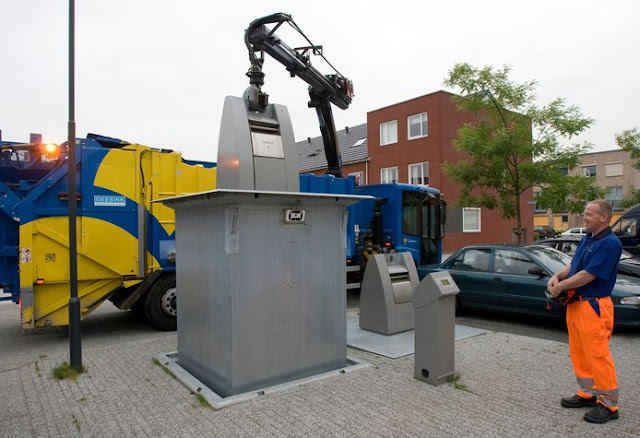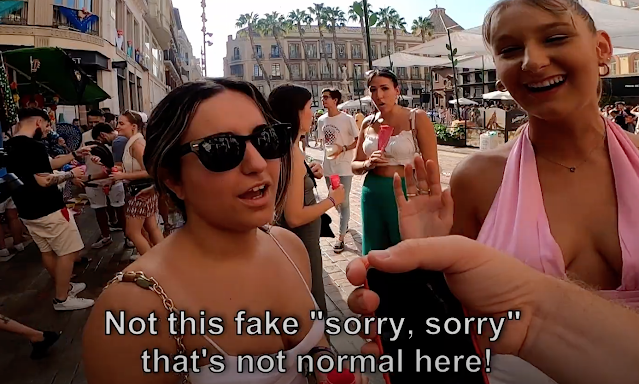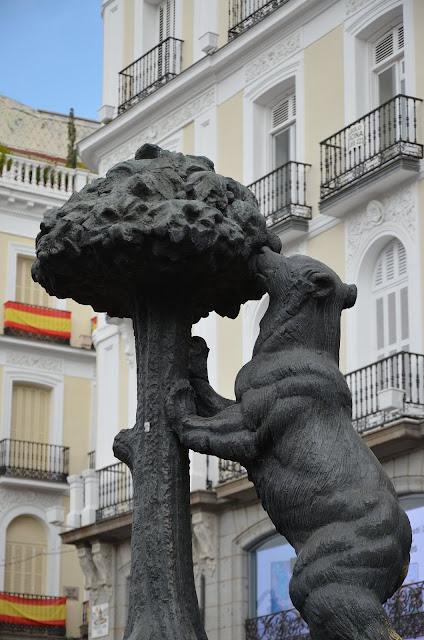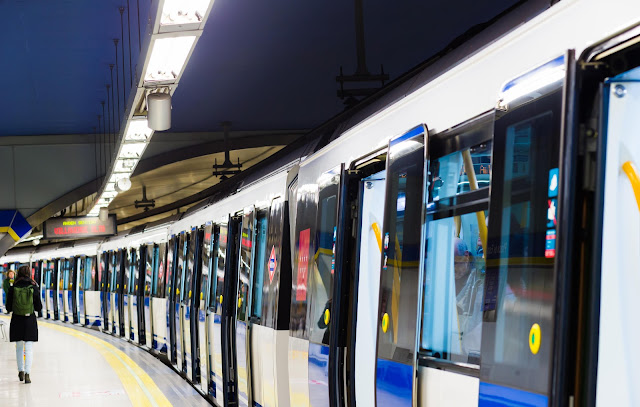We awoke in our queen-sized bed and loved the breeze coming through the open French doors. We started our day by opening their exterior shutters to let more light in. Wearing the hotel's slippers and robes, we stood on the balcony and relished the quiet morning and crisp November air.
Our hotel offered a buffet breakfast (for additional cost)...
... but we preferred to eat out at local places. Spain is on the continent but it eschews a Continental Breakfast. Instead, Spaniards eat savory foods, and we prefer that. (We are unlike the Americans who crave over-sugared breakfast foods).
We strolled through the charmingly narrow lanes to Plaza de Santa Ana.
It existed since the Spanish Golden Age: the Renaissance of flourishing arts and sciences. It is named for a Carmelite monastery that stood there in the 1600s. In 1810, Joseph Bonaparte was the kingdom’s ruler (1808-1813)—after his brother, Napoleon, conquered Spain. Joseph demolished the monastery to create a more sanitary/posh area. It was completed in 1880. Now, the perimeter of the square is almost entirely covered by cafe terraces and coffeeshops. From morning to midnight, it was always lively yet orderly. It was fun to pass through and feel the convivial vitality of people.
Let's discuss the language. Coming from the USA—with huge influence from Latin American immigrants (whose nations were colonized by Spain)—we assumed that the language in Spain was named Spanish (Español). No. It is named Castellano. That refers to the Province of Castille where the language originated.
That reminded us of how outsiders say that people in the Netherlands are Dutch. That’s incorrect. People in the Netherlands are Netherlanders who have a Netherlandish culture and speak Nederlands. Nobody is Dutch; that is a mis-labelling that was caused by English-speakers. *To see our amazing time in the Netherlands, please use this link: https://halfwindsorfullthrottle.blogspot.com/2019/08/our-trip-to-netherlands-part-1-of.html
There is an important distinction of languages within Spain.
Castilians reside in the historical region of Castile, and that includes Madrid. When they speak, their unique pronunciation makes “cilantro” sound like “thilantro” and “Zoro” sounds like “Thoro”. “Gracias” sounds like “Grathias”. Other regions of Spain don't speak like that, and Latin Americans do not speak like that. Thus, people in/from Madrid speak with a distinctive Castilian “th” sound. (Our friend in NYC is from Madrid, and when he speaks to Latinos and Latinas and says “Grathias”, they instantly recognize where he’s from).
From there, we used more irregular lanes that are preserved from their medieval origins.
We paused to admire the incongruent intersection at Calle de la Cruz that still had those quaint attributes.

We ate at a "local spot" with food that is so famous that it attracts foreign travelers, yet it is somehow unchanged in its original coziness. Casa Toni is an old-school Tapas Bar.
It began in the 1970s. It might look "basic", but that belies the succulent recipes therein! The prices remain fair, with generous portions = great value! The small restaurant has two levels, but "the action" occurred on the main level. A stubby bar connected to a grilling area where a pudgy man was talented with knives and spatulas to cook/char the legendary recipes perfectly.
People come-and-go, and the vivid people-watching is enhanced by pedestrians outside. Despite only being open for 20 minutes, the room was almost full. Fortunately, we snagged the last "standing table" in the center of the room.
Customers varied from trendily-dressed couples to old bearded men wearing denim jackets and leather pants. We observed many Chinese visitors who also appreciated savory food to start their day. Please enjoy Lewis' panoramic video...
Regardless of the time of day, everyone drinks wine or beer. We didn't see anyone sipping juice or coffee. We smartly chose glasses of red wine to accompany our food.
As the second-most mountainous nation in Europe, Spain’s geography is ideal for growing grapes. Continuous sunshine across the kingdom during most of the year helps, too. Spanish wine is often aged longer than others, which creates deeper flavors. 600 varietals are nurtured on Spanish soil!
The menu was printed in Spanish and English, and Lewis gestured for a busy waiter to take our order. Without using paper/pen, he memorized everything. He got some things wrong, but those items weren't wasted; they were promptly served to other tables. We had a feast, and we were thankful that our standing-table had two levels, so dirty dishes could be put below and make room for new ones.
Rinones plancha (Kidneys cooked on the griddle) €5.20.
Callos (sautéed Beef Tripe) €10.50. Made with chorizo and chickpeas, it's a classic dish in Madrid, and it's popular across the country.
Grilled Squid €10.80. Since we were in a nation surrounded by a lot of water (Atlantic Ocean, Bay of Biscay, Mediterranean Sea), it was sensible to have seafood. Spain's world-famous speed trains ensure that freshly-caught seafood is transported immediately to the capital.
Revuelto Setas con Gam (Scrambled forest mushrooms with eggs) €13.
Mollejas Plancha (Sweetbreads from the griddle) €12.50. That was my favorite. It's a healthy and delicious dish.
The food came with replenished "peasant loaf" bread. Four glasses of locally-made wine cost a total of €11.20. We were obliged to give a 10% gratuity of €5.75, which pleased our waiter. If you want to taste Spain's authentic gastronomy, that is the place to go!
A husband and wife at the next table admired our food and inquired about it. They asked us to take their photograph with their camera. Delighted by our affable American charm, they invited us to join their table.
The young woman was from Hong Kong (Lewis already knew that by detecting her accent when she spoke Mandarin), and her husband was a policeman from Macao. When I revealed that my grandfather had been a village policeman, he perked up and clinked glasses with me. (To say "Cheers" in Spanish is Salud!) The woman worked for a company that made gaming machines for casinos. It was their tenth visit to Spain, and they always return to Casa Toni because of its unaltered excellence.
The wine flowed, and we chatted merrily with our newfound acquaintances. They usually travel without itineraries, and they were wowed with ours. We mentioned the musical-theater performances that we had tickets for, and they were impressed that a pair of Americans wanted to attend a show that was performed in a foreign language. I said that half of our Netflix shows are made in other countries, and we happily enjoy them with subtitles or voiceovers. We discussed our upcoming dinner reservations at Soy Kitchen, which is the only Chinese restaurant in the kingdom to win a Sol Repsol award. (Spain's version of Michelin Stars). The woman remained skeptical of its perfection (and later we found out why), but she applauded our keen interest to immerse ourselves in other cultures.
That couple also enlightened us about why our personalities were so appreciated in Spain: we were not typical Americanos. Using my Xiaomi phone (mostly blockaded by the American government because it's better than what lazy/greedy American companies make), I quickly found online interviews that showed how badly Americans personified themselves abroad.
It's worthwhile to watch these two short videos, too. The second one is poignant...
Thankfully, our values make Lewis and I exceptional Americans!
Together, the four of us walked to Sol.
We parted ways at the Metro station. It's gorgeously modern.
(We remain connected as penpals via social media. It's nice befriending people in other parts of the world).
Lewis and I rode north to Alonso Martinez Station.
Lewis noticed a sign that is posted on every train; it assures riders that trains refresh their air every 2.5 minutes and that every train is disinfected daily. Wow, that's impressively responsible.
Nothing like that exists in NYC—even after the rest of the world learned cleanliness from the COVID pandemic (not surprisingly, NYC handled COVID the worst out of every city on the planet). Unchanged for 100 years, NYC's subway trains are rarely cleaned. Authorities wait for rain to rinse the exteriors, and overpaid employees are supposed to clean/mop/disinfect the interiors whenever trains reach the end-of-the-line. But, they merely drag a mop—full of uncleaned water—down the middle of the train...
(maybe wipe a few poles) and then they revert their focus to the cellphones... a habit they probably learned from NYC's police. Their union claims that those hundreds of idle employees are being paid to "observe others for the purposes of training and development".
Aboveground, most Metro stations are adorned with fanciful iron railings that survive from the 1920s. They were designed by Antonio Ramilio (born 1874), and they give Madrid an iconic appearance that is unique. Using an Art Moderne style, Ramilio modernized the city in ways that reminded us of Metro stations in Paris. Similarly, Madrid's monumental buildings on wide boulevards also resembles Paris.
We intended to visit the Museum of Romanticism. It is a state-owned facility that opened in 1924 from the aristocratic patronage of the Marquis of Vega-Inclan. It was his art collection. However, we experienced a reoccurring problem with Google Maps that we first witnessed in Germany (where the company has a feud with the government so it deliberately gives inaccurate information to be unhelpful). The map began automatically zooming-out—while I tried to use—and it spun around and then zoomed-in to a random place. It seemed like a prank... that continued for the rest of our trip. We hated it. It also failed to show transit stops, and it failed to identify transit routes (that happened in Norway and Germany, too). When I tried to "plan a route" between destinations, it gave bank directions...
We expect reliability from a billion-dollar conglomerate. (But remember that Google is an American one, so its focus is greed and not providing what it says it will). With growing frustration, I relied on Madrid's transit webpage to see accurate maps, but we were lost whenever we walked on streets and alleys between them.
As such, we accidentally encountered a film crew preparing to make a vintage scene on one of the historic streets.
Those men were not wearing vintage costumes; they were members of the Civil Guard, and their ceremonial uniforms retain those tricorne hats and shoulder-straps. They patrol rural areas as the national gendarmerie.
We asked a guy in the crew for directions to the museum. After an uncertain pause, he said that we had to walk for 13-minutes in the opposite direction. That didn't seem correct, and nobody else spoke English, so we abandoned our plans. That was the third museum that we failed to visit. Retracing our steps to the Metro, we decided to try again at the Sorolla Museum. To our angst, it was closed AGAIN. Once AGAIN, there was no sign on the entrance to explain why. Also once again, Google claimed that it should be open on that day. We didn't want to attempt visiting the Lazaro Museum. Instead, we opted to go to the zoo.
15-20% of Spain’s population is actually Jewish but the modern generations don’t know it because of the Spanish Inquisiton. Most of the Jews in the UK originated in Spain and fled there as refugees and emigres. According to Spanish law—as an admittance of their wrongdoing—if modern Jewish people prove that they have 50% Spanish ancestry, they will grant citizenship.
This year, 506 restaurants won "One Sun" (seen below, the plaque looks like an egg yolk). 164 got "Two Suns". 43 earned "Three Suns".
18 years ago, a chef named Yong Ping Zhang relocated from Tianjin, China to Spain. He changed his name to Julio Zhang. His Asian-fusion restaurant is popular. This year, it celebrated its tenth anniversary. It's the only Chinese restaurant in Spain to win a Sol Repsol award. We definitely wanted to dine there, so we made online reservations two months before our trip.
The interior is sleekly eclectic, with slight nuances to Asian styles—but nothing that denotes Asia.
There was confusion when we arrived. A hostess escorted us to our table: one in a row that faced a long bench. (The bench is too low and cushy, so everyone who sat on it had to sit on the pillows that were intended for their backs). The hostess departed without providing menus, and there was no QR code to scan. Within moments, a waitress paused at our table to take our cocktail order, but we explained that we lacked menus. She left but never returned. A minute later, a young man wearing a suit paused at our table to ask if we knew what food we wanted to order? He seemed to be the dining room captain. With patience, we asked for menus. He provided them. Then, we had trouble signaling someone to take our order. They hurried back-and-forth, although the restaurant was only half-full.
The same thing happened to the older couple who sat next to us. Things got better when a young couple sat on our other side because we commandeered the waitress who escorted them and asked her to take our drink order. As soon as she left, the suited man came to take our drink order. With a raised eyebrow, I said that we just gave it to somebody else. Laughing, he said, "I'm sorry; I'm always coming at the wrong time." If that's the case, he's in the wrong profession.
Our cocktails were quite tasty, but I don't recall what we had.
Lewis perused the wine list. Finally, the captain's timing was helpful, and he arrived to discuss vintages. We drank a Verdejo produced by Marques Riscal. It's one of the oldest wineries in the wine region of La Rioja, and it was founded by Camilo Hurtado de Amezaga, the Marquis of Riscal. Now, it has a "creatively modern" building on its ancestral land.
Each customer had utensils and a knife-rest that shared its space with a pair of chopsticks. I'm nimble with chopsticks, so I happily used them.
As an amuse bouche, the kitchen presented us with small cups of mushroom soup, flavored with herbs and lemongrass.
From the menu, we both had cockles with a crab dumpling. (Chef Zhang makes the dough for his dumplings).
Monkfish fillet, topped with caviar and red onion.
After each course, our dirty dishes were removed and then a dark-skinned woman—who seemed like she didn't care about her job—put clean utensils on our table. Unlike other servers who position the silverware in front of customers (and some make sure the handles are at the edge of the tables), she merely plopped them on our table. Waitresses at our local diner are nicer than her. She never smiled, made eye contact, or asked if she could do anything for us. That uncaring behavior doesn't belong in an upscale eatery. If you win a high-caliber award, all employees must be polite... and preferably efficient. That doesn't happen at Soy Kitchen, and nobody (chef or manager) is watching to fix it.
Next, we ate Bone Marrow, blended with truffles and spring onion.
It was accompanied by two puffy buns that were pan-fried in olive oil (which made the exterior gooey). We were told to break off pieces of bun and spread marrow on them. It was delicious.
(We went to the lavatory to wash our hands after that, and the single toilet area is disappointingly dingy and tight).
With anticipation, we tasted the chef's Soup Dumplings: each of us got only one dumpling. At least the crimping was perfect, and the dough was infused with squid ink. There was a decent amount of broth inside, but we had better ones elsewhere. For a high-end restaurant, it was disappointing that they still used paper doilies under the dumplings. Anyone knows that paper sticks to the dough and when you try to peel it off, it usually causes the dumplings to rupture (and lose their precious broth). That happened to Lewis before he could get his spoon under the dumpling. Bad design. A man from China should know better.
As a main course, we shared the "deconstructed" Lobster. Yes, it was separated on a platter, but the kitchen lazily did not remove the meat. Customers were given shell-crackers and picks to do that... yet none of the employees considered how messy that is—liquid squirting across the table, fragments of shell and wet bits of seafood being flicked. In our opinions, some parts were undercooked. I wanted to send it back to the kitchen, but Lewis was disinterested.
As another main course (because a small lobster offers a tiny amount of food for two people), we ordered the Soy-Ginger Beef. The fork-tender morsel was succulent and delicious.
We didn't see it on the menu, but Lewis noticed another table feasting on duck, so we requested it from the captain. He was charmed that we were interested. It was a Peking-style "lacquered duck" recipe that is a highlight of the Chef's Tasting Menu. (The food included in the Chef's Tasting Menu is never printed on the menus because Chef Zhang expects you to trust him). It took a long time to prepare that entree.
Twice, the chef came out of his kitchen—dressed casually in a shirt, slacks, and baseball cip—to visit two tables. Then, he returned to the kitchen. We always think it's rude when a chef enters the dining room and neglects to greet each table. If you go to one table, then go to all of them. Don't ignore your other customers; it implies that they are insignificant.
We didn't need their services; our hotel was sufficient.
On the topic of "sweet stuff", we ended our night with the flan that we bought at the supermarket. It only cost €1.50, it was the market's brand (made with wholesome ingredients), and it tasted better than the dessert at Soy.
Please join us in the next part to see our fun-packed weekend!
Cuídate! (See you soon!)



















































































.svg.png)

































































































No comments:
Post a Comment
Don't be shy: leave your comments :)